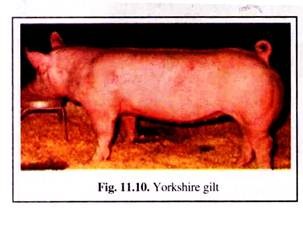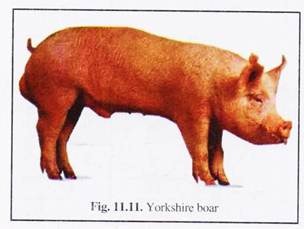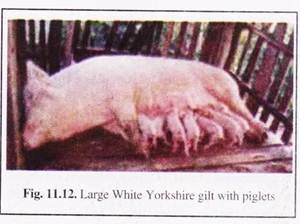The following points highlight the four main points to be considered while selecting pigs for farming from available breeds. The points are: 1. General Form or Types 2. Size or Weight for Age 3. Development in the Regions of High-Priced Cuts of Pork 4. Quality – Performance or Productive Ability.
1. General Form or Types:
As for form or type, a desirable gilt or sow presents a well-balanced appearance (Fig. 11.10). From the side view, the top line appears as a strong uniform arch; the underline is straight; the legs are medium in length; the sides are deep and long. As viewed from the front or rear, the shoulders, back, loin and rump are fairly wide, and the width is carried uniformly from front to rear.
2. Size or Weight for Age:
Gilts do not show as much depth of body as sows and consequently appear more “leggy” at the younger age. A desirable animal has a large heart girth, as indicated by the distance around the body just behind the shoulders. The head is trim in appearance with good width at the snout and between the eyes. The face is medium in length, varying somewhat with the breed.
3. Development in the Regions of High-Priced Cuts of Pork:
ADVERTISEMENTS:
A good gilt or sow shows a reasonable amount of development in the regions of the high priced cuts of pork chops, which come from the back and loin; ham, which comes from the rear quarters; and bacon, which comes from the sides. Therefore, selection of animals having wide, full hams is essential. Preference should be given to a body that is wide over the back and loin and long and deep.
Pedigree:
A pedigree is the statement of an animal’s ancestry. In addition to the names and herd- book numbers of the animals in each of several generations, usually it includes also the date of birth of each animal and the name of the breeder. It may extend back to the beginning of a breed’s record history, or only for two or three generations.
In a real sense, a pedigree is good or bad, according to as the individuals in it are good or bad. The better the individuals, the more uniform they are in the type of performance desired, the more prepotent and uniform the breeding qualities of the individual may be expected to be.
4. Quality – Performance or Productive Ability:
ADVERTISEMENTS:
It is desirable to consider actual performance, or productive ability of an animal. In the case of a gilt or a sow, one measures efficiency of rate of gain as shown by its weight for its age. In the case of a sow, information on the number of pigs in each litter that she has farrowed, number of piglets raised per litter and the weight of the litter should be considered.
Prepotency or transmitting ability:
Prepotency is the ability to transmit characteristics to the offspring to a marked degree. It refers to either male or female.
From a genetic standpoint, there are two requisites that an animal must possess in order to be prepotent:
ADVERTISEMENTS:
(a) Dominance and
(b) Homozygosity.
If a given boar or sow possesses a great number of genes that are completely dominant for desirable type and performance and if the animal is relatively homozygous, in that case it can be said that the animal is a prepotent.
A desirable boar is larger for his age and heavier of bone than gilt, and he shows masculinity and ruggedness, rather than feminity. As with gilt, a boar should be 4 to 6 months of age at the time of selection since serious defects in type are not so likely to develop after this age is reached.
Selection of Gilts (Female):
Selection of gilts for the breeding herd should be made at market weight, i.e., when the animals weigh about 90 kg. Gilts should be selected from sows which have consistently farrowed and weaned large litters (Figure 11.10).
They will reach market in minimum time and have desirable market type. It would be desirable to choose gilts whose litter and other full sibs have given good performance in daily weight gain and feed conversion efficiency.
Selection of Boars (Male):
Selection of boar is extremely important, particularly for a small breeding farm or unit. The boar should be purchased from a breeder or a farm maintaining adequate information on its performance. The boar should be selected from a dam which has consistently farrowed and weaned high litters.
ADVERTISEMENTS:
A good boar which attains weight of 90 kg in about 5-6 months, will be of good type and will be strong on feet and legs (Fig. 11.11). The feed conversion from weaning to 90 kg weight would be the most desirable.
Points to be Considered while Replacing Boars and Gilts:
The mother of the pig to be selected should have had large litters of 8 piglets or more (Fig. 11.12). The weaning weight (at 56th day) of a litter in case of a gilt selection should have been 120 kg and in the case of sow it should be not less than 150 kg.
The gilt or the boar should have reached a body weight of about 90 kg in about 6 months. The pig should have adequate length and depth of the body, thick well- muscled hams should be firm and trim. The pig should have sound feet and legs.
For gilt back fat thickness of 4 cm or less and for boars 3.2 cm or less is ideal. Gilts should have a minimum of 12 evenly spaced, functional teats. An animal with blind teats should be avoided as there will be little or no milk from these teats and the defect is heritable.
Negative blood test for both brucellosis and leptospirosis should be made during selection and the pigs should be vaccinated against swine fever. Pigs should be free from other diseases and physical defects.


